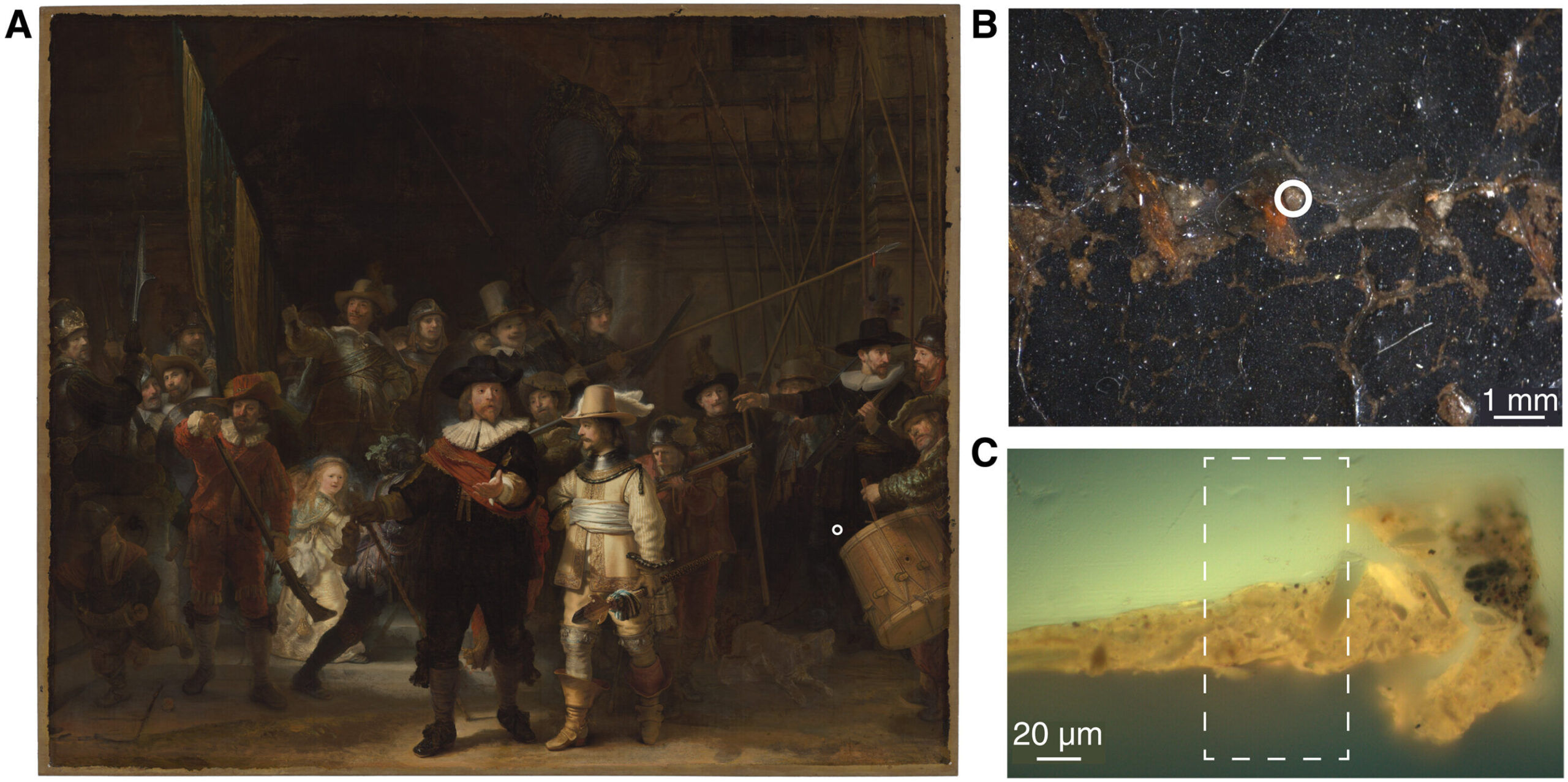
![The Night Watch by Rembrandt van Rijn with the sample location and paint sample studied with correlated tomography. (A) The Night Watch by Rembrandt van Rijn (1642, Rijksmuseum Amsterdam, 378.4 cm by 453.0 cm) with an indication of the general sample area (white circle). (B) Photomicrograph of the area corresponding to sample SK-C-5_003 (white circle) of the exposed quartz-clay ground (C) embedded paint fragment under a light microscope [ultraviolet (UV), 365 nm]. The white dotted rectangle shows the examined area using correlated tomography. Credit: Science Advances (2023). DOI: 10.1126/sciadv.adj9394 Rembrandt broke new ground with lead-based impregnation of canvas for The Night Watch](https://scx1.b-cdn.net/csz/news/800a/2023/rembrandt-broke-new-gr.jpg)
The Night Watch by Rembrandt van Rijn with the sample location and paint sample studied with correlated tomography. (A) The Night Watch by Rembrandt van Rijn (1642, Rijksmuseum Amsterdam, 378.4 cm by 453.0 cm) with an indication of the general sample area (white circle). (B) Photomicrograph of the area corresponding to sample SK-C-5_003 (white circle) of the exposed quartz-clay ground (C) embedded paint fragment under a light microscope [ultraviolet (UV), 365 nm]. The white dotted rectangle shows the examined area using correlated tomography. Credit: Science advances (2023). DOI: 10.1126/sciadv.adj9394
New research has revealed that Rembrandt impregnated the canvas for his famous 1642 militia painting “The Night Watch” with a lead-containing substance even before the first primer was applied. Such lead-based impregnation had never before been observed in Rembrandt or his contemporaries. The discovery, published in today Science advancesunderlines Rembrandt’s inventive way of working, in which he did not hesitate to use new techniques.
The surprising observation is another result of Operation Night Watch, the largest and most wide-ranging research and conservation project in the history of Rembrandt’s masterpiece. It resulted from advanced analysis of an actual paint sample taken from the historical painting.
The first author of the paper is Fréderique Broers, a researcher at the Rijksmuseum and Ph.D. student with professors Katrien Keune (University of Amsterdam), Koen Janssens (University of Antwerp) and Florian Meirer (University of Utrecht). Her research forms part of the research project 3D Understanding of Degradation Products in Paintings of the Netherlands Institute for Conservation+Art+Science+ (NICAS).
Brothers and colleagues used a combination of X-ray fluorescence and ptychography to identify and visualize sub-microscale chemical compounds in the lower layers of the canvas. By sampling the small Nagwag paint fragment at DESY (Deutsches Elektronen-Synchrotron, Hamburg), they discovered the lead-rich layer beneath the quartz-clay ground layer of the canvas.
Protection against moisture
It was already known from earlier studies that Rembrandt used a quartz-clay ground on the Night Watch. In earlier paintings he used double grounds, consisting of a first ground containing red earth pigments followed by a second lead-white ground. The large size of The Night Watch may have motivated Rembrandt to look for a cheaper, less heavy and more flexible alternative to the ground layer.
Another issue he had to overcome was that the large tarpaulin was intended for a damp outer wall of the great hall of the Kloveniersdoelen (musketeer shooting range) in Amsterdam. It was reported that under humid conditions the common method of preparing the canvas with animal glue may fail. A contemporary source on painting techniques written by Théodore de Mayerne suggested impregnation with lead-rich oil as an alternative. This may have inspired Rembrandt for his unusual impregnation procedure to improve the durability of his masterpiece.
Computational imaging
The presence of this lead-containing ‘layer’ was discovered through the first ever use of correlated X-ray fluorescence and ptychographic nano-tomography on a historical paint sample. It was performed at the PETRA III synchrotron radiation source at DESY. X-ray fluorescence is used to investigate the distribution of relatively heavy elements (calcium and heavier). Ptychography, a computational imaging technique based on experimentally obtained data sets, is capable of visualizing even the lightest elements and organic fractions.
Analysis of the microsample taken from The Night Watch revealed that on the side of the sample closest to the sail support, a homogeneous layer of dispersed lead was present in the soil layer. Since lead components were not expected in the quartz-clay soil layer, this was a rather puzzling observation. The results were then combined with the lead distribution map of the full Night Watch, obtained by X-ray fluorescence scanning of the painting in the Rijksmuseum’s Gallery of Honor.
This map shows the presence of lead throughout the painting and suggests application using large semicircular brush strokes, supporting the assumption that it results from an impregnation procedure. Even a print of the original sieve on which the cloth was stretched when the preparatory layers were applied is visible in the lead distribution map. This brings us another step closer to understanding Rembrandt’s creative process painting The Night Watch, as well as its current state.
More information:
Fréderique Broers et al, Correlated X-ray Fluorescence and Ptychographic Nano-Tomography on Rembrandt’s The Night Watch Reveals Unknown Lead ‘Layer’, Science advances (2023). DOI: 10.1126/sciadv.adj9394. www.science.org/doi/10.1126/sciadv.adj9394
Provided by
University of Amsterdam
Quotation: Study shows how Rembrandt broke new ground with lead-based impregnation of canvas for The Night Watch (2023, December 15) retrieved December 16, 2023 from https://phys.org/news/2023-12-rembrandt-broke-ground- lead -based-impregnation.html
This document is subject to copyright. Except for any fair transaction for the purpose of private study or research, no part may be reproduced without written permission. The content is provided for informational purposes only.
LivU Video Chat: Proven Strategies for Free Coins
How to Earn Free Spins in Coin Master: Step-by-Step Tutorial
Free TikTok Coins Today: Quick Tips
La formule secrète de la génération de pièces sur TikTok
LivU Video Chat Free Coins Hack: Elevate Your Conversations
Boost Your Coin Master Progress with Free Spins
TikTok Coin Hacks for Content Creators
مولدي العملات TikTok: نصائح للاستفادة القصوى
LivU Video Chat Free Coins Hack for Chat Enthusiasts
Legitimate Ways to Get Free Spins in Coin Master
Unlocking Free Avacoins in Avakin Life: A Comprehensive Guide
Get Free Credits in Bingo Blitz: Tips and Tricks
How to Get Spins in Coin Master Legally and Quickly
9 easy ways to get free primogems in genshin impact one esports
How to Earn ZEPETO Zems: Step-by-Step Tutorial
match masters all boosters match master free booster
How to Earn TikTok Coins: Step-by-Step Tutorial
Unlimited TikTok Coins: Myth or Reality?
Générateurs de pièces TikTok : Mythe ou réalité ?
The Science of Free Coins Farming in LivU Video Chat
Coin Master Free Spins Today: Quick Tips
Avakin Life Avacoins Hack: Boost Your Virtual Wealth for Free
Bingo Blitz Credits Farming: Your Ultimate Guide
TikTok Coin Farming: What You Need to Know
Conseils des pros : Stratégies de récolte de pièces TikTok




